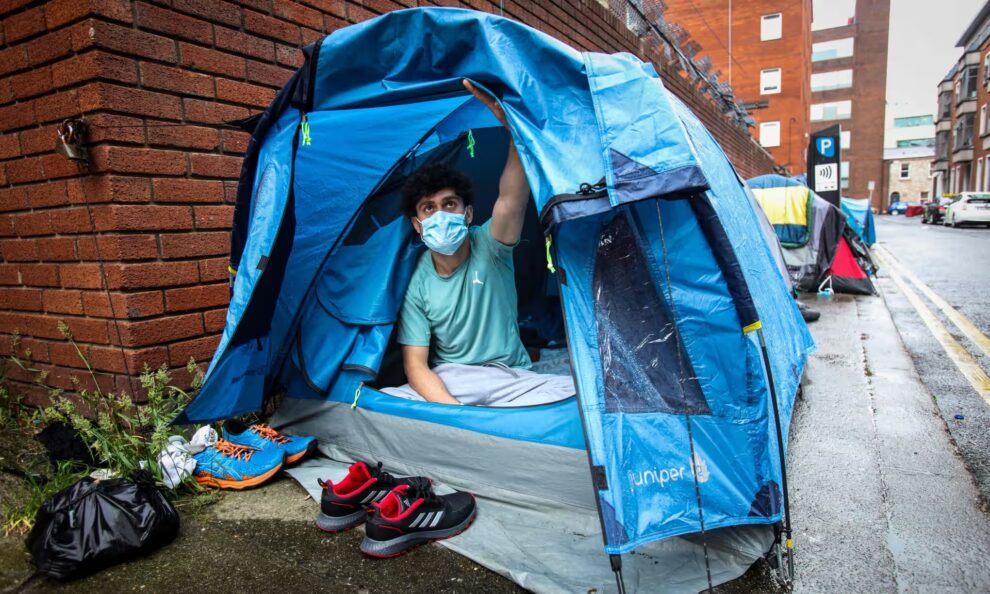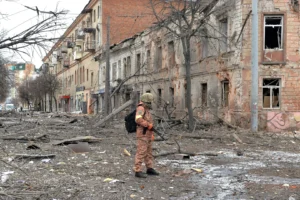Ireland is in a dark place. Riots in Dublin last month exposed to the world the presence of a small, nascent but emboldened far right. A complex range of factors underlie this: social media conspiracy theories, toxic masculinity, an ugly underbelly of racism and persistent social and economic inequalities. But the far right is also weaponising a decade-long housing and homelessness crisis that afflicts the entire country and has placed thousands of people in a state of chronic housing stress, anxiety and fear.
The riots did not surprise those of us who have been warning about the rise of racism directed at immigrants. We have seen how the housing crisis is used to whip up hate against newly arriving asylum seekers. It doesn’t much matter to those who attack temporary accommodation centres for refugees that such buildings would never become private homes. Their message is that Ireland is “full” and we should house “our own” first.
The truth, however, is that Ireland’s shortage of affordable housing has not been caused by an increase in numbers of immigrants or refugees, but by 30 years of policies that have left delivery to the property market while decimating social housing. My phone pings daily with messages on social media from people who are losing their home. In the past few days, a disabled woman asked me to share her plea for “immediate accommodation”, as she is being evicted. A worker for Dublin city council is being evicted, but he and his family can’t afford any of the rents on flats they have viewed. He told me: “I clean our streets every day, and I haven’t even a home I can clean for myself.”
Hundreds of thousands of similar stories can be heard across Ireland. The president, Michael D Higgins, does not have a political role, but he has attacked the handling of the housing “disaster”, calling it “our great, great, great failure”. Housing is consistently the number one issue of concern for the Irish public. In the spring 2023 Eurobarometer poll, 61% of people in Ireland cited housing as one of the two most important issues facing the country. Just 10% of people across the EU highlighted housing as one of the two most important issues.
The facts are startling. Ireland used to have one of the highest rates of home ownership in the EU. But despite near full employment and record economic growth in recent years, just 66% of housing is owner-occupied now, down from 79% in 1991. Home ownership has collapsed particularly among younger generations and lower-income groups. Today, less than a third of 30-year-olds own their home.
This shift is hardly a surprise when you look at house prices, which are now on average almost eight times the national average wage. In Dublin, they are more than 10 times the average wage. In the years 2012 to 2022, wages increased by 27%, compared to a 75% increase in residential property prices, and a 90% increase in rents.
The average Dublin rent is now €2,102 a month. That is equivalent to the entire monthly take-home pay of a newly qualified teacher. Since 2015, rents have increased by 13% across the euro area, but in Ireland they’ve increased by 60%. And this is despite a rent cap on existing rental tenancies.
Spiralling rents are directly connected to the fact that most of the new-build housing supply is expensive, investor-fund build-to-rent, backed by government through tax breaks and incentives. In 2022, 58% of all newly built homes in greater Dublin were bought or developed by investor funds. Countless people are being locked out of buying a home by the reliance on these global vulture funds. I prefer to call them vampire funds because they seek not to buy and sell, but to extract high rents in perpetuity.
Griffith Wood, for example, is a new Dublin apartment complex of 342 homes built in 2021. The entire development was bought by Greystar, a global real-estate investment company that entered the Irish housing market in 2019. A one-bedroom flat in the complex is now advertised to rent for €2,150 a month, while a two-bed is a cool €3,335.
If crippling rents were not enough, tenants endure chronic insecurity. Unlike in many other European countries (but similarly to the UK), private landlords can evict tenants who are paying their rent for “no fault” reasons.
Thirty thousand households, or just under one in 10 of every renting household, were evicted in the past three years alone. A no-fault eviction ban introduced in 2022 lapsed in March this year, and more than 15,000 notices of termination have been issued so far in 2023. That is more evictions than during the height of the Famine, when an average of more than 8,000 households were evicted annually.
Combined with a dire lack of social housing, the current rate of evictions means Ireland has the highest levels of homelessness on record. Based on my research, I estimate that 23,881 individuals are homeless, almost double the level recorded in officialstatistics. Adding hidden homelessness, a reliable estimate is nearly 75,000 people – almost six times the official statistic.
The new evictees aren’t being put out of their homes by immigrants or asylum seekers, but by landlords seeking to raise rents on new tenancies or turn the properties into Airbnbs. There are now 14 times as many properties advertised on Airbnb in Ireland as there are advertised to rent long term.
The current crisis has deep roots. From the 1980s, Irish governments, like Margaret Thatcher’s Britain, began to shift away from building council housing. Ireland already had a longstanding policy of supporting tenant purchase via loans, but public housing was sold off on a massive scale and remaining social housing communities were progressively more stigmatised. Two-thirds of social housing built in Ireland since the 1930s has been sold by the state into private ownership.
Local authorities were further undermined during the boom Celtic tiger years of the mid-1990s to 2007, as social housing was outsourced to private developers and private rental schemes. But rather than transforming the housing model after the 2008 crash, the policy adopted to achieve economic “recovery” included pushing up property prices so that the asset value of housing held on banks’ balance sheets would rise again, making banks solvent, and recovering the investments of Celtic tiger developers.
Successive governments (led mainly by the centre-right Fine Gael party, with, from 2011 to 2016, Ireland’s Labour party), used post-crash austerity to completely dismantle the social housing delivery capacity of local authorities. In 2007, local authorities built in the region of 6,000 homes; in 2014 they built just 102.
The state agency set up in 2009 to take over “bad” property loans from the banks meanwhile sold off huge amounts of land and apartments at major discounts to global real-estate funds, and even social housing schemes were developed for them. A US investor last month bought a €75m “portfolio” of 156 apartments, now leased as social housing on a 25-year deal with a Dublin local authority.
Much of the present crisis is not in fact a result of “failures” of housing policy, but is actual government policy: promoting the financialisation of housing and prioritising the commodity value of housing over the basic need for a home. Many politicians view private renters as little more than – as the taoiseach, Leo Varadkar, described it in the Dáil – a landlord’s income.
Attitudes of fiscal conservatism dominate, which restrict investment in public housing even when the money is available. In the most recent budget, a €12bn surplus was put into paying down the national debt and pension funds rather than investing in housing, exacerbating the sense of generational injustice.
The housing crisis is now a “catalyst” for anti-immigrant sentiment, an Irish parliamentary committee warned in November. “It creates an impression of resource scarcity and competition for services, which hampers integration and feeds into racist and far-right narratives and an ‘us and them’ mentality,” their report concluded. Last week, in a worrying sign that it is itself playing anti-immigrant politics while failing to prioritise housing, the government announced it had run out of accommodation for new asylum seekers, who would be offered tents and sleeping bags instead.
The question we should be asking is: who benefits when migrants and refugees are scapegoated for anger about housing? Landlords, investor funds and private developers can all sit back and charge higher rents while claiming (falsely) that the problems are down to “scarcity of homes” and “supply and demand’” in the light of a growing population. But housing outcomes are not just determined by the market – the state can also play a central role, as it has done in Austria (in Vienna, 50% of all housing is public housing, built for all income groups), and as it did across the UK and Ireland in the past, to ensure there is enough housing, and that social housing needs are met.
We can provide enough homes for all of us. Ireland has huge numbers of vacant and derelict properties and available land. We have the wealth and finance to provide sufficient housing. We could form a public construction company that could transform public housing delivery. It is the self-imposed economic straitjacket of restricted investment that is causing this shortage. Refugees did not cause the housing crisis. The responsibility for scarcity, hoarding and accumulation of property. wealth and land by a tiny elite lies squarely with Irish governments, banks, developers and investor funds.
Where I see hope is in evidence of a generational shift in attitudes. Opinion polls show a majority in favour of inserting a right to a home in the constitution and majority (85%) support for a decline in house prices. Hope is visible too in the “Ireland for all” demonstrations that began earlier this year.
The real danger remains, however, that the far right continues to grow and turn anger about the housing catastrophe away from the actual causes and on to vulnerable refugees, asylum seekers and immigrants, continuing the age-old tactic of divide and conquer. The poor and working people blame each other; while the rich win, again.
Source : The Guardian











